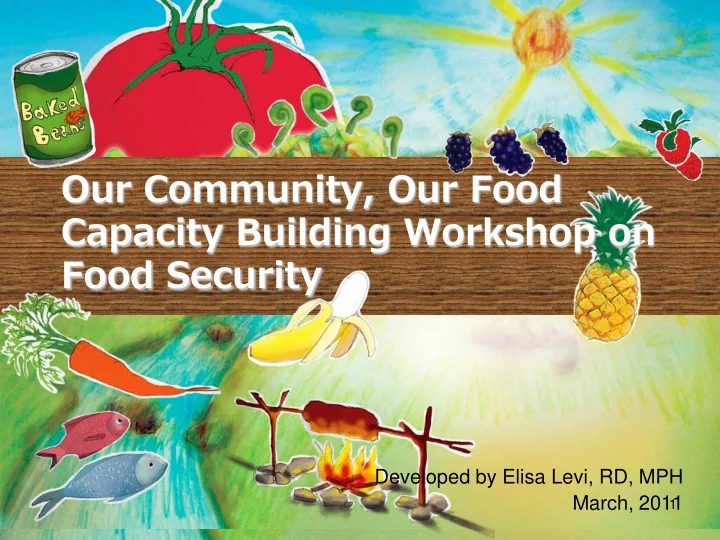

Our Community, Our Food Capacity Building Workshop on Food Security Developed by Elisa Levi, RD, MPH March, 2011 1
Participants will • Learn that increasing food security is important to preventing diabetes and promoting healthy communities • Learn strategies that may help improve food security in your community • Be able to identify and access additional information for addressing food security in your community 2
Welcome 3
Food and Diabetes, Food and Health • Healthy food choices are essential to support overall health, and to help prevent or manage diabetes • For people living in remote and northern communities and those with low incomes, there are barriers to healthy eating, such as high food prices and limited availability of healthy food • This means that people may have to choose less healthy, lower cost foods 4
Food Security, Food Insecurity • Food Security is when all people have enough food to be healthy. – The food must be: available, affordable, safe, nutritious and culturally acceptable. – Includes traditional, locally produced and store bought foods. • Food Insecurity is the opposite of food security. It means not having enough healthy food. 5
Cultural Food Security • “Cultural food security” is important to many First Nations, Inuit and Métis people • It means having access to traditional foods, and also having access to traditional food knowledge Photograph: Ice Fishing in Baffin Island Encyclopedia Britannica. Online 31 Jan 2011 6
Food Security and Nutrition • Food security and nutrition have an important relationship – healthy food needs to be available and accessible so that people can choose it to support their healthy eating practices 7
Idea Generating Activity 8
Feasting For Change 9
Model for Promoting Food Security in First Nations and Inuit Communities
Points Within Traditional and Market Food Systems For Promoting Food Security • Harvesting – community hunts, hunter/ harvester support programs • Production – greenhouses, gardens • Preparation and Processing – cooking classes, canning, drying fish, traditional food processing plants • Storage – community freezers, storage areas for traditional and store food 11
Points Within Traditional and Market Food Systems For Promoting Food Security • Marketing – working with retailers to market healthy foods, sale of local foods • Distribution – community hunts, sharing networks, community freezers • Purchasing – food vouchers, food cooperatives • Transportation – subsidies for transporting food, harvesting equipment such as boats and ATVs • Consumption – promote healthy eating, breastfeeding, school meal programs 12
Let's Get Up and Move Around! • Activity to see how other communities are addressing food security: – Look at the community “solutions” posted on the wall. These are examples of what is happening in communities to help improve food security. – Think about assets and resources in your community that you could build on to start new projects and activities. 13
What's Happening Across Canada? • Using the handout on your table and the conceptual model, review and discuss the case study that has been assigned to your table: – What point within the traditional and market food system does the initiative or program address (refer to model)? – Would it work within your community (why or why not)? – How could it be adapted in your community? 14
Creating A Food Security Plan Deliver Discover Design Dream Adapted from: Ross, S. and Simces, Z (2008). Community Food Assessment Guide. Provincial Health Services Authority. British Columbia. Draft 15
“OUR FOOD IN HOPEDALE” Development of a Community Food Action Plan Why? Inuit communities continue to face challenges accessing adequate amounts of nutritious foods 4. Identified goals to implement 1. Created an inventory and monitor the community’s food of past and present security priority actions: community food security • Increased access to traditional projects and programs foods and existing assets • Increased access to fresh produce Deliver Discover • Increased use of traditional knowledge, skills and language • Increased food education and awareness 2. Conducted community Design Dream 3. Developed an action plan to consultations to identify achieve ‘the dream’ (step 2) priorities and solutions Adapted from: Ross, S. and Simces, Z (2008). Community Food Assessment Guide. Provincial Health Services Authority. British Columbia. Draft 16
Many solutions are needed and you can help! 17
Recommend
More recommend